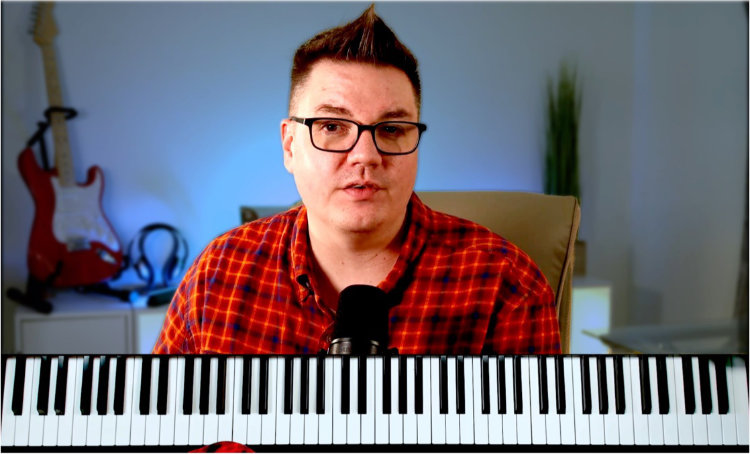Minor chords are one of those basic concepts we learn when we first take music lessons. But, we need to learn how to voice them in our hands, so they sound musical in the tunes we play.
How do I voice a minor 7th chord? A minor 7th voicing needs to include its most important 3 notes, including the root, flat-3rd and flat-7th. The root is played in the left hand, with the 3rd and 7th in the right hand.
This article is part of my series on Foundational Chord Voicings. Make sure to check out the other relevant parts of this series on major chord voicings, and dominant chord voicings.
The Notes of the Minor 7th chord #
What is a minor 7th chord? A Minor 7th chord is a 4-note chord consisting of the root, flat-3rd, fifth and flat-7th. You can build the chord upwards from its root by stacking minor-3rd, major-3rd and minor-3rd intervals.
You can also think of this as taking the 1, 3, 5 and 7 from the Aeolian mode.
Here's a Cmin7 chord:

Step-by-Step Video Training
As a premium member of Jazz-Library you will have access to our Jazz Fundamentals video course which has 70+ video lessons teaching you these chords, chord voicings, comping rhythms and more.
Root Position Voicing #
The basic voicing shown above is known as a root position voicing. It's the most basic form that this chord takes, and while we use it all the time, it's not always the most appealing way to voice this chord. With that in mind, its essential to understand the notes of the chords before we can move into jazzier voicings.
Minor 7th Chords in Root position: #

Minor 7th Chord Inversions #
In order to achieve the best voice leading as we play these voicings in a tune, we'll need to rearrange the notes into inversions. Inverted chords are built by reassembling the root position chords by taking 1 or more more notes off of the bottom of the voicing, and replacing them with notes an octave higher at top of the voicing.
Minor 7th Chords in 1st Inversion: #
1st Inversion chords are built by taking 1 note off the bottom of the root positioned voicing, and moving it up an octave to the top of the voicing.

Minor 7th Chords in 2nd Inversion: #
Similar to 1st Inversion chords, 2nd Inversion chords are built by taking 2 notes off the bottom of the root positioned voicing, and placing them on top of the voicing.

I've taken some of these down the octave, just to make them easier to read on the staff.
Minor 7th Chords in 3rd Inversion: #
Lastly, 3rd Inversion chords are built by moving 3 notes from the bottom to the top.

3-Note Voicings #
As we progress into building jazzier voicings, we begin with the simplest of jazz voicings, the 3-note voicings. The 3-note voicing is a simplified voicing, with only 3 instead of 4 notes: the root, the 3rd and the 7th. We leave out the 5th.
(Aside: The 5th is not really essential as it doesn't differentiate minor chords from major chords. Both major and minor chords are defined by their 3rds and 7ths, but have the same 5th. As such, we can make our lives easier and just think 3's and 7's.)
3-Note can be played in either hand, or split between the hands. I suggest learning them first by playing the root in your left hand, and the 3rd and 7th in your right hand.
A-Voicings #
There are two variations of 3-note voicings that you should learn. Both have the root note in your left hand. In this A voicing, the 3rd is on the bottom of your right hand, and the 7th on top:
Here's a Cmin7 chord as an example:
B-Voicings #
For B voicings, the root stays in your left hand, but you switch to play the 7th on the bottom of the right hand.
Here's the same Cmin7 chord in B voicing:
Rootless Voicings #
3-note voicings are great, and we use them all the time. But they also sound a little thin. Jazz pianists love to create thick, lush chords stacked full of notes. To take the next step in that direction, we take our 3-note voicings and we add a couple more notes:
As the name "rootless" implies, these voicings no longer contain the root (the root is often played by a base player in an ensemble). So, we'll remove that note from our voicings. For minor 7th chords, we add the 5th back in, as well as a new note, the 9th.
You should learn to play these voicings fluidly in both your right and left hands.
A-Voicings #
Since our rootless voicings are based on the 3-note voicings, they also have A and B voicings. Just like our 3-note voicing, the A-voicing below has the 3rd on the bottom.
The A-voicing is structured as 3-5-7-9.
B-Voicings #
Similarly, we build B-voicings using the same note with the 7th on the bottom.
The B-voicing is structured as 7-9-3-5.
Extended Minor 7th Chords with the 11th #
You can enhance the sound of your minor-7th chords further by introducing the 11th for some color. There are many creative ways to voice this into your chords, and you'll usually need to consider melody or voice leading in the context of the tune your are playing. So, use your ears, and try out various ways to introduce it into your playing. This one note can make a big difference!
Here's an example of one of my go-to voicings for a Cmin7 chord, with the 11th (F) added. It follows the same structure as our Rootless A-Voicing.
Fourth Voicings #
Up to this point our voicings have been based around minor chords built by stacking 3rds (1,3,5,7,9,11), and related inversions. We can create a more modern jazz sound by using the same notes, but stacked in 4ths instead.
My examples below use the following sequence of notes in 4th intervals to build voicings: 11-7-3-5-1. These voicings have 5 notes and are shown in 4 different inversions. This can be a little weird, especially if you have a long history of playing classical music. Keep with it, the results are worth the effort.
Pro tip: I find it much easier to think about building fourth voicings from the top down, rather than from the bottom up, though that's not a hard and fast rule. Starting from the main chord tones on top and extending the chord as I go down just works better for me.
Also, don't get confused if sometimes we stray slightly from strict fourth intervals. Using the right diatonic notes is what matters most, moreso than strict adherence to the mathematical interval structure. For example, in our first voicing below there's a major-3rd between the Eb and G, but the rest of the intervals are perfect 4ths.
Inversion with Root on Top #
Inversion with 3rd on Top #
Inversion with 5th on Top #
Inversion with 7th on Top #
Practice Tips #
In order to use these voicings in songs and improvisation, you'll have to internalize them. Here are some exercises I use to get comfortable:
- Play them through the circle of 5ths, counter-clockwise and clockwise.
- Play them chromatically
- Play them in diatonic scales
- Use flash cards to drill them randomly.
Play all four of those techniques with the chords in your right hand, then in your left, and then both hands together.
